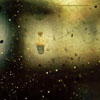Robert Hampson, "Signaux", "Suspended Cadences"
 Hampson released the exceptional Répercussions earlier this year, his first full length since 2008's Vectors. Now he has followed that up with two more albums, released simultaneously but presented separately. Even though he has become suddenly prolific, both albums are of the utmost quality, and have a distinctly different approach to sound between them.  And yes, fans of Loop and Main, there are guitars.
Hampson released the exceptional Répercussions earlier this year, his first full length since 2008's Vectors. Now he has followed that up with two more albums, released simultaneously but presented separately. Even though he has become suddenly prolific, both albums are of the utmost quality, and have a distinctly different approach to sound between them.  And yes, fans of Loop and Main, there are guitars.
Signaux is more in league with Hampson's acoustimatic work on Répercussions and Vectors:a microcosmic world of miniature sounds and alien melodies that flow splendidly into one another.Suspended Cadences, however, is more of a throwback to some of his earlier Main material, no doubt because of his reintroduction of guitars to that album.It is not a nostalgia trip though, it just sounds like the natural evolution of that sound.
Signaux is constructed solely from analog electronic sources and only utilizing computers as a point of recording and editing, so the sounds generated become a complete mystery, sounding like nothing and no one else.Even though the album is split into two side-long pieces, anyone familiar with Hampson's work knows that he rarely stands still, and these two are constantly evolving and changing, mixing dense complex passages with more airy ones..
"Signaux 1" began life as an eight channel installation work, mixed down into a standard stereo mix.Digital noises that lie somewhere between chirping crickets and skipping CDs blend with heart monitor beeps in the opening minutes, along with his trademark oddly filtered, tactile textures.The piece emphasizes texture and microscopic noises, occasionally with oddly resonating, elongated tones.It is the antithesis of drone, in that it never seems to stop moving like a living, breathing organism.
On the B side, "Signaux 2," composed just for this album, follows a similar template, although it does emphasize the tones a bit more than the textures, though both are equally represented.Rather than just tones, there is a rhythmic, occasionally percussive undercurrent in the piece and quite different from the one that preceded it, but it very much feels like the second half of the same work.
 
sample:

Also a two side-long track affair, Suspended Cadences is Hampson's long-awaited return to guitar, in addition to analog electronics.The use of guitar is immediately noticeable on "Suspended Cadences (Three)" (parts one and two were only performed live), although in execution it has a different quality entirely.Long, sprawling tones and a looming hum bear all of the hallmarks of the instrument, but reshaped and molded into something distinctly unique.Less about texture and more about tones, there is an alternating between shimmering, beautiful passages and ugly, distorted outbursts.
"Suspended Cadences (Four)" leans more into a minimalist drone, with subtly shifting guitar tracks layered together, slowly moving and evolving throughout.There is a fair amount of processed and effected electronic ambience to be had, but the focus is definitely on the subtle hums of a guitar amplifier, or the resonating buzz of feedback.
Releasing these two albums independently from one another makes a lot of sense, given that they are significantly different from one another in content and execution.The more electronic-focused Signaux may exhibit more variation and change in its approach, but the sonic character of Robert Hampson's guitar mangling never disappoints.Neither one is better than the other, largely because they are so different, but their differences also complement each other beautifully.
samples:
 



